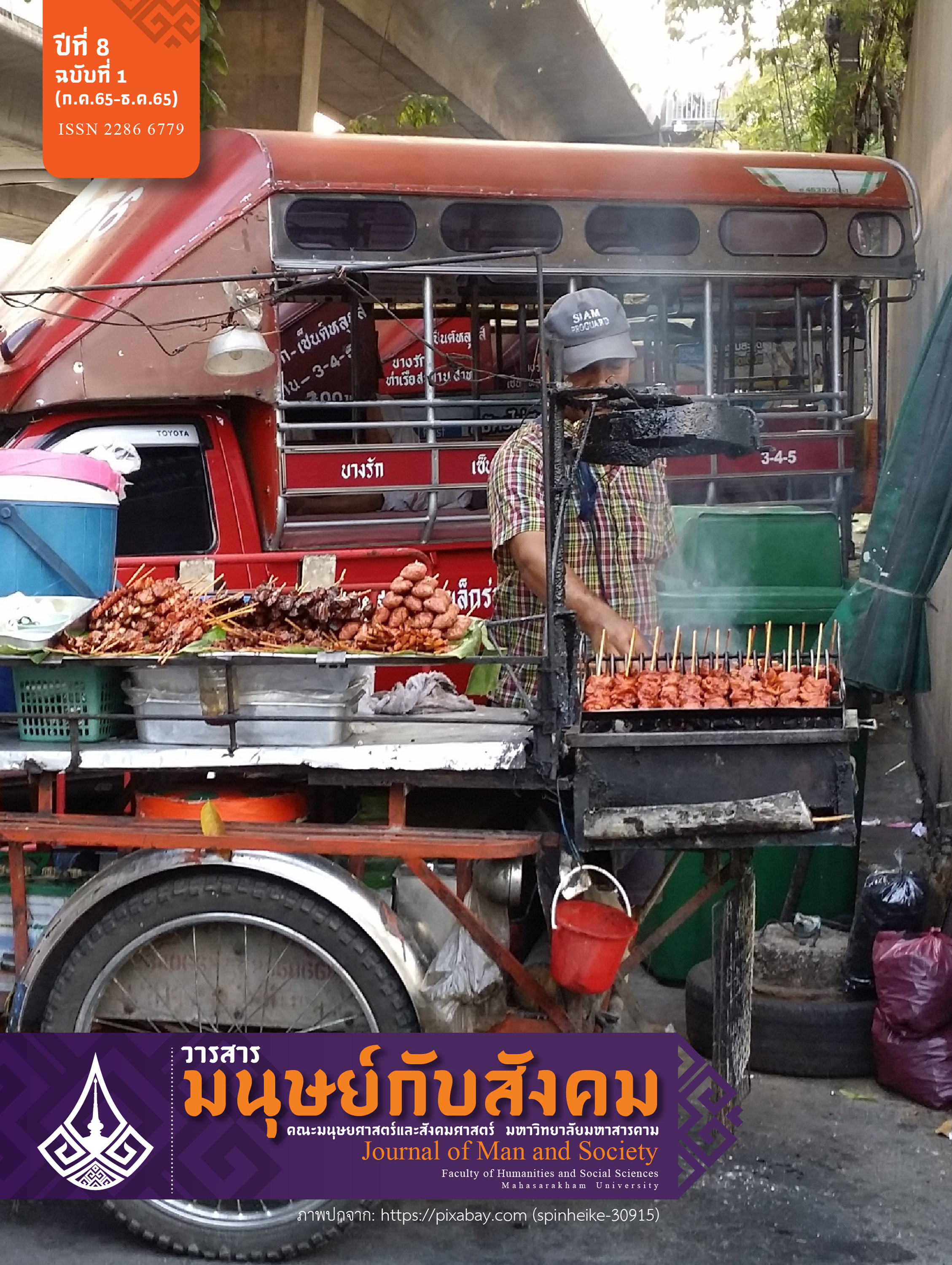The Use of English Language in Expressing Thai Cultural Words
Main Article Content
Abstract
This research aims to categorize cultural words and study strategies of using English cultural words to convey Thai culture. The data is collected from “Thai passage” in “Sawasdee” E-magazine, an in-flight magazine of Thai Airways International Public Company Limited. The researchers adopt Nida’s framework (1975) in analyzing and categorizing cultural words. Also, the cross-cultural communication strategies used in this study were based on Baker’s framework (1992). For the findings, 265 cultural words were found and can be categorized into 4 groups including ecology cultural words, material cultural words, linguistic cultural words, and social cultural words. The uses of English language to express Thai cultural words were 1) using a loan word or loan words plus explanation 2) paraphrasing by using unrelated words 3) using literal meaning 4) cultural substitution 5) omission 6) using more general words 7) paraphrasing by using related words and 8) using more neutral or less expressive words.
Article Details

This work is licensed under a Creative Commons Attribution-NonCommercial-NoDerivatives 4.0 International License.
เนื้อหาและข้อมูลที่ตีพิมพ์ลงในวารสารมนุษย์กับสังคม ถือเป็นข้อคิดเห็นและความรับผิดชอบโดยตรงของผู้เขียนซึ่งกองบรรณาธิการวารสารไม่จำเป็นต้องเห็นด้วยหรือร่วมรับผิดชอบใดๆ
บทความ ข้อมูล เนื้อหา รูปภาพ ฯลฯ ที่ได้รับการตีพิมพ์ในวารสารมนุษย์กับสังคม ถือเป็นลิขสิทธิ์ของวารสาร หากบุคคลหรือหน่วยงานใดต้องการนำทั้งหมดหรือส่วนหนึ่งส่วนใดไปเผยแพร่ต่อต้องอ้างอิงวาสาร
References
คู่มือเหรียญสะสมและธนบัตร. (2557). ความรู้เรื่องปี้โรงบ่อนและบ่อนเบี้ย. [ออนไลน์]. ได้จาก: https://www.facebook.com/771046806295057/posts/787357924663945/ [สืบค้นเมื่อ 31 ตุลาคม 2564].
งามพิศ สัตย์สงวน. (2531). มานุษยวิทยา: มโนภาพ “วัฒนธรรม”. วารสารสังคมศาสตร์, 26(1), 1-27.
ฉัตรระวี สุคนธรัตน์. (2542). บทบาทในการสื่อสารระหว่างประเทศของนักการทูต. วิทยานิพนธ์ปริญญานิเทศศาสตรมหาบัณฑิต สาขาวิชานิเทศศาสตร์พัฒนาการ คณะนิเทศศาสตร์ จุฬาลงกรณ์มหาวิทยาลัย กรุงเทพฯ.
พงศกร เมธีธรรม. (2560). ภาษาอังกฤษในฐานะภาษานานาชาติ: มายาคติ อำนาจ และการครอบงำ. พิษณุโลก: มหาวิทยาลัยนเรศวร.
วราพัชร ชาลีกุล. (2560). กลวิธีการแปลคำทางวัฒนธรรมจากภาษาไทยเป็นภาษาอังกฤษกรณีศึกษาเรื่อง เรื่องของจัน ดารา แต่งโดย อุษณา เพลิงธรรม. สารนิพนธ์ปริญญาศิลปศาสตรมหาบัณฑิต สาขาวิชาการแปลภาษาอังกฤษและไทย คณะศิลปศาสตร์ มหาวิทยาลัยธรรมศาสตร์ กรุงเทพฯ.
วิมลวรรณ อังสุวรรณ. (2550). ปัญหาความไม่เท่าเทียมกันทางความหมายของคำและกลวิธีการแปลที่ปรากฏในวรรณกรรมเยาวชน เรื่อง “The Happiness of Kati” ของ Prudence Borthwick. วารสารภาษาและวัฒนธรรม, 26(1), 172-187.
ศิรินาถ บูรณพงษ์. (2544). กลวิธีการแปลวรรณกรรมพุทธศาสนาจากภาษาไทยเป็นภาษาอังกฤษ. วิทยานิพนธ์ปริญญาศิลปศาสตรมหาบัณฑิต สาขาวิชาภาษาและวัฒนธรรมเพื่อการสื่อสารและพัฒนา บัณฑิตวิทยาลัย มหาวิทยาลัยมหิดล นครปฐม.
สัญฉวี สายบัว. (2560). หลักการแปล. พิมพ์ครั้งที่ 9. กรุงเทพฯ: มหาวิทยาลัยธรรมศาสตร์.
สาโรจน์ บัวพันธุ์งาม. (2564). การเปลี่ยนแปลภาษาของคำยืมภาษาบาลีและสันสกฤตในปัญญาสชาดกฉบับล้านนา. วารสารมนุษยศาสตร์วิชาการ, 28(1), 188-227.
สุพรรณี ปิ่นมณี. (2562). ภาษา วัฒนธรรมกับการแปล: ไทย-อังกฤษ. กรุงเทพฯ: จุฬาลงกรณ์มหาวิทยาลัย.
หนึ่งฤทัย ลาที. (2556). การวิเคราะห์การแปลภาษาอังกฤษเป็นภาษาไทยจากหนังสือเรื่องแอตแลนติก มหาสมุทรข้ามกาลเวลา. วิทยานิพนธ์ปริญญาศิลปศาสตร มหาบัณฑิต สาขาวิชาภาษาอังกฤษเพื่อการพัฒนาอาชีพ คณะภาษาและการสื่อสาร สถาบันบัณฑิตพัฒนบริหารศาสตร์ กรุงเทพฯ.
อธิศา งามศรี. (2560). กลวิธีการแปลคำและวลีทางวัฒนธรรมที่พบในบทแปลจากภาษาไทยเป็นภาษาอังกฤษ กรณีศึกษาหนังสือเรื่อง “ครูบ้านนอก” โดย คำหมาน คนไค. สารนิพนธ์ปริญญาศิลปศาสตรมหาบัณฑิต สาขาวิชาการแปลภาษาอังกฤษและไทย คณะศิลปะศาสตร์ มหาวิทยาลัยธรรมศาสตร์ กรุงเทพฯ.
Hapsari, N. D. and Setyaningsih, R. W. (2013). Cultural Words and the Translation in Twilight. Anglicist, 2(2), 75-81.
Hofstede, G & Hofstede, G. J. (2005). Cultures and Organizations: Software of the mind Revised and Expanded (2nd edition). USA.: McGraw-Hill.
Inveen, V. (2019, November). Single and ready to travel. Sawasdee, 56-61.
Nida, E. A. (1975). Exploring Semantic Structures. Munchen: Wilhelm Fink.
O’Connell, R. (2019, August). Thailand’s gilded glory. Sawasdee, 48-53.
Tylor, E. B. (1871). Primitive Culture. London: John Murray.


